Hensoldt Dialyt 10x50
SonderbauweiseBei diesem 10x50 Dialyt handelt es sich um eine Sonderanfertigung oder Prototypen für ein Dialyt-Fernrohr, eventuell für das baugleiche Hensoldt 10x50 Münzfernrohr. Hensoldt hat in diesem Monokular ebenfalls ein Abbe-König-Prisma eingebaut, dessen Prismenstuhl sich nicht wie bei den üblichen Dialyten von unten aus dem Prismengehäuse nehmen lässt, sondern von der Okularseite her, indem die Abdeckplatte abgeschraubt wird. Die blanke Aluminium-Abdeckplatte und die Objektivfassung sind mit "Hensoldt Dialyt 10x50" bzw. dem Hensoldt-Logo beschriftet. Die Abdeckplatte ist auch mit der +/-5 Skala für den Dioptrienausgleich gekennzeichnet. Ein Referenzstrich befindet sich am schwarz lackiertem Messingokulardrehtubus. Die Augenmuschel ist aus blankem Aluminium. Das konische Gehäuse hat einen eckigen Sockel (evtl. auch für eine Montage vorgesehen) und eine gegenüberliegend angebrachte Abdeckplatte. Beide Teile sind mitsamt dem Gehäusetubus mit Leder ummantelt. Das Dialyt ist recht schwer - 774g - so dass es vermutlich eine Sonderanfertigung für die Industrie (ggf. Militär) oder ein Prototyp für ein kleins Spektiv/Aussichtsfernrohr war. Die Baumerkmale und die unvergütete Optik weisen auf eine Produktion vor 1940 hin. |
Special DesignThis 10x50 Dialyt is a special construction or prototype for a Dialyt Scope - quite likely for the Hensoldt 10x50 Coin-operated Telescope of the same construction. Hensoldt made it with an Abbe-König prism. The prism chair can be pulled out at the eyepiece side after unscrewing the cover plate there, a way contrary to the usual Dialyts of which their prism charis can be pulled out from the bottom of the prism housing (after unscrewing the objective tube and some locking screw). The polished aluminium cover plate and the objective frame are marked "Hensoldt Dialyt 10x50" and with the Hensoldt logo. The cover plat is also engraved with a dioptre scale of+/-5. A reference line is on the black painted brass eyepiece. The eyecup is made of aluminium. The conical body has a rectangular base (probably inteded for mounting) and a cover plate on the opposite side. Both parts and the whole tube are covered with leather. The Dialyt is quite heavy weighing 774g so that is was especially made for some industrial (or maybe military) use or it is a prototype for a small spotting or look-out. Its characteristics as well as its uncoated optics hint to a production date before 1940. |
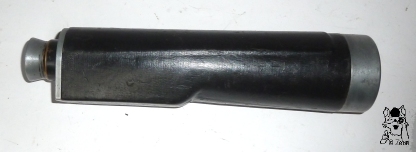
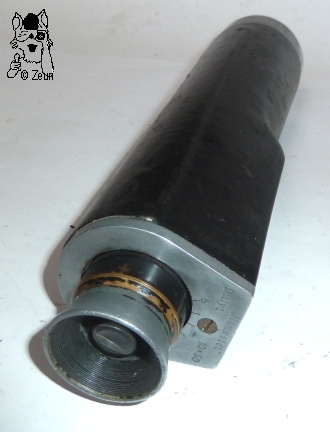
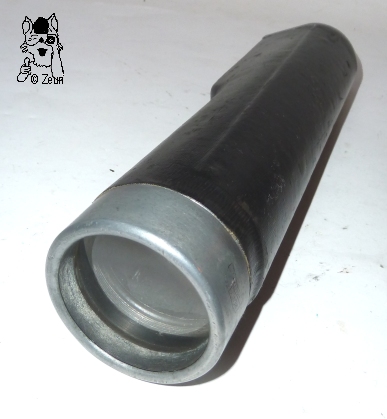
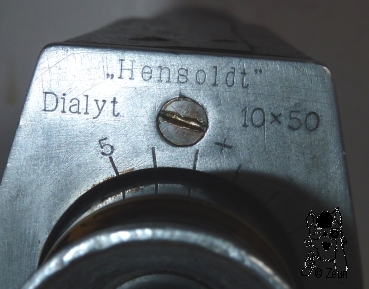
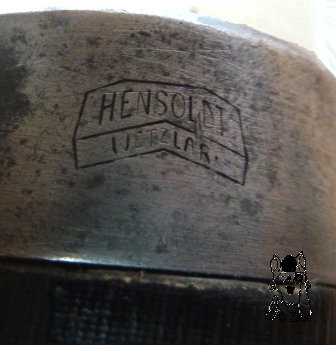
| Das 10x50 ist 248-258mm lang. Die Augenmuschel ist 33,5mm, das Okularstück 32mm und die Objektivfassung 60mm im Durchmesser. Der Tubus verbreitert sich von 50mm auf 60mm, der ca. 93mm lange Sockel ist am äußeren Abschluss 37mm breit. Siehe auch die Beschreibung auf H. Leichtfrieds Website. |
The 10x50 is 248-258mm long. The eyecup is 33.5mm, the eyepiece 32mm, and the objective frame 60mm in diameter. The tube increases from 50mm to 60mm, the about 93mm long base is 37mm wide at its outward end. Also see H. Leichtfried's description on his website. |
Fotos: Zeun

